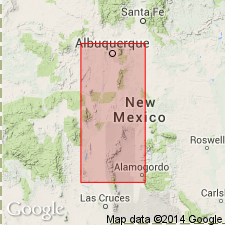
- Usage in publication:
-
- Warmington limestone member
- Modifications:
-
- Named
- Dominant lithology:
-
- Limestone
- AAPG geologic province:
-
- Orogrande basin
- San Juan basin
Summary:
Name proposed for basal 22 ft of Elephant Butte formation (new) of Armendaris group (new) of Des Moines series. Type locality is section measured in west end of Whiskey Canyon in north portion of Mud Springs Mountains, just west of westernmost box canyon, in southwest part of sec 1, T13S, R5W, Sierra Co, NM in Orogrande basin. Composed of medium-gray to light-gray, dense limestone. Beds are massive to nodular, highly cherty. Has been traced over much of central NM, as far north as north of Sandia Mountains in San Juan basin, south to Franklin Mountains in extreme southern NM. Contains a distinctive fusulinid fauna, the oldest definite representative of genus FUSULINA known from the Pennsylvanian in NM. Contains other fusulinid genera as well. Warmington species of FUSULINELLA are among the most highly developed forms of that genus known from NM. Overlies Cuchillo Negro formation of Mud Springs group of Derry series (all new) with probable unconformity; underlies upper part of Elephant Butte formation of Armendaris. Is of Pennsylvanian (Des Moines) age.
Source: GNU records (USGS DDS-6; Denver GNULEX).
For more information, please contact Nancy Stamm, Geologic Names Committee Secretary.
Asterisk (*) indicates published by U.S. Geological Survey authors.
"No current usage" (†) implies that a name has been abandoned or has fallen into disuse. Former usage and, if known, replacement name given in parentheses ( ).
Slash (/) indicates name conflicts with nomenclatural guidelines (CSN, 1933; ACSN, 1961, 1970; NACSN, 1983, 2005, 2021). May be explained within brackets ([ ]).

